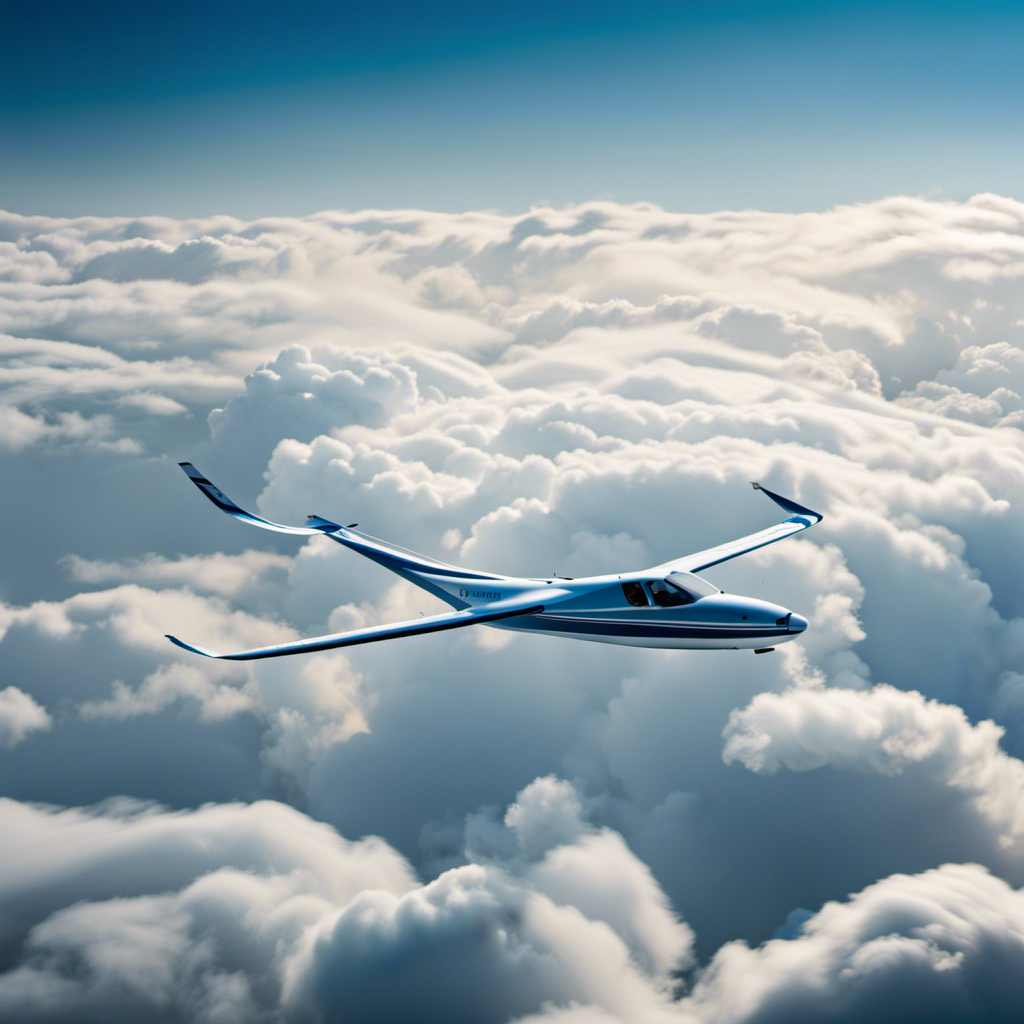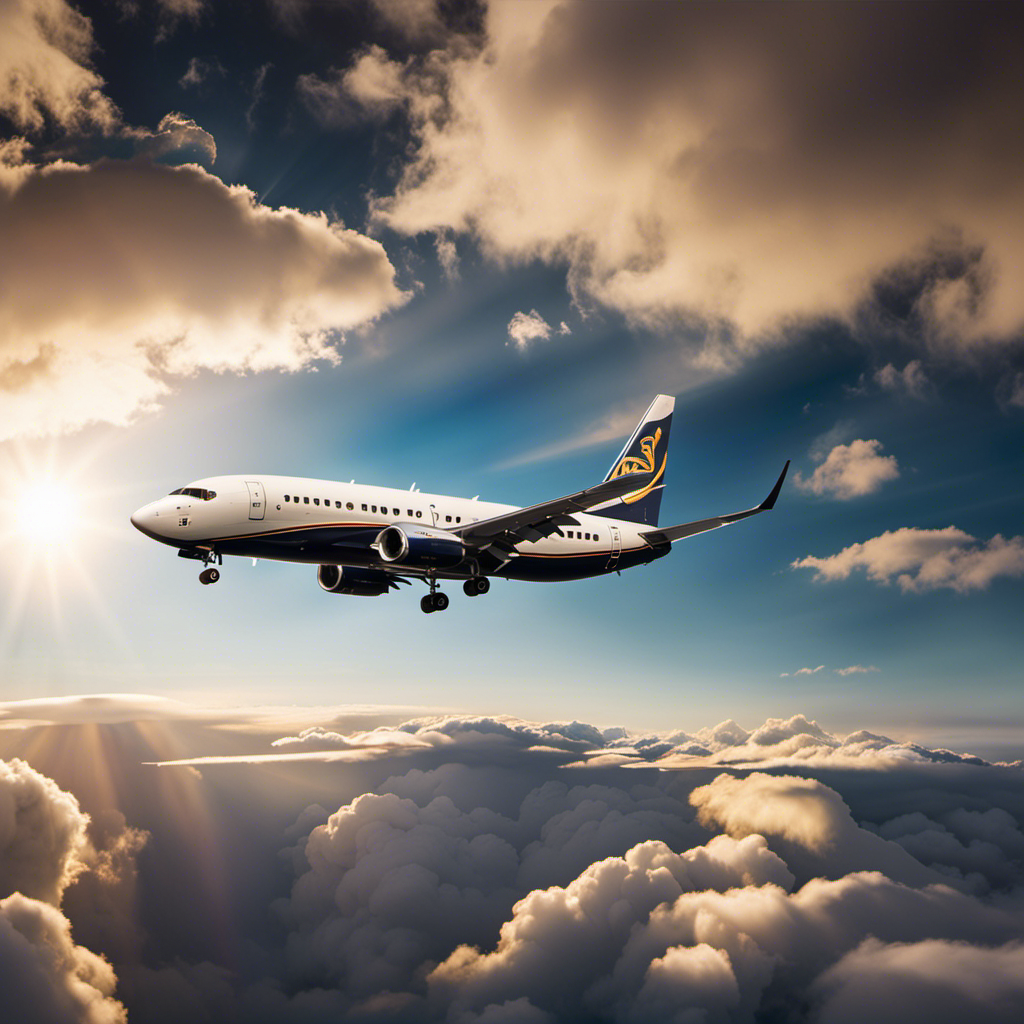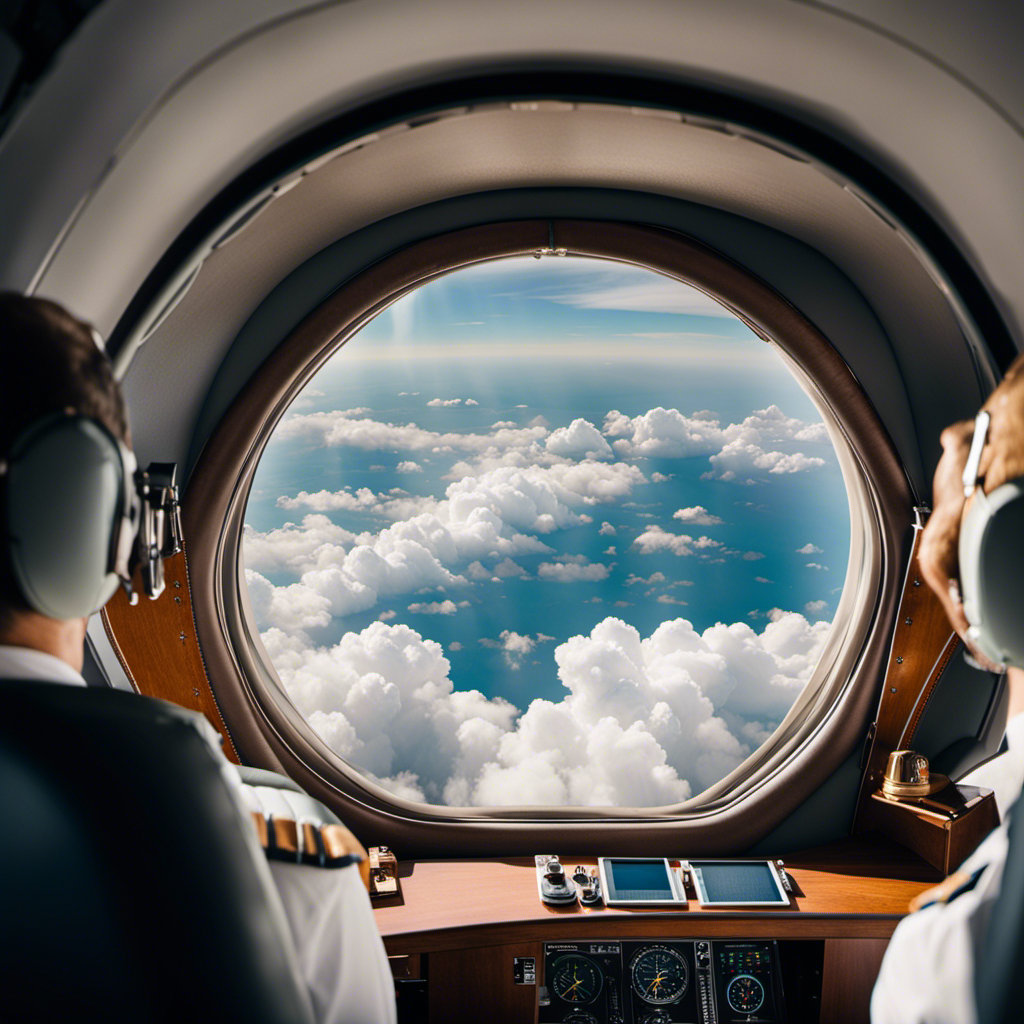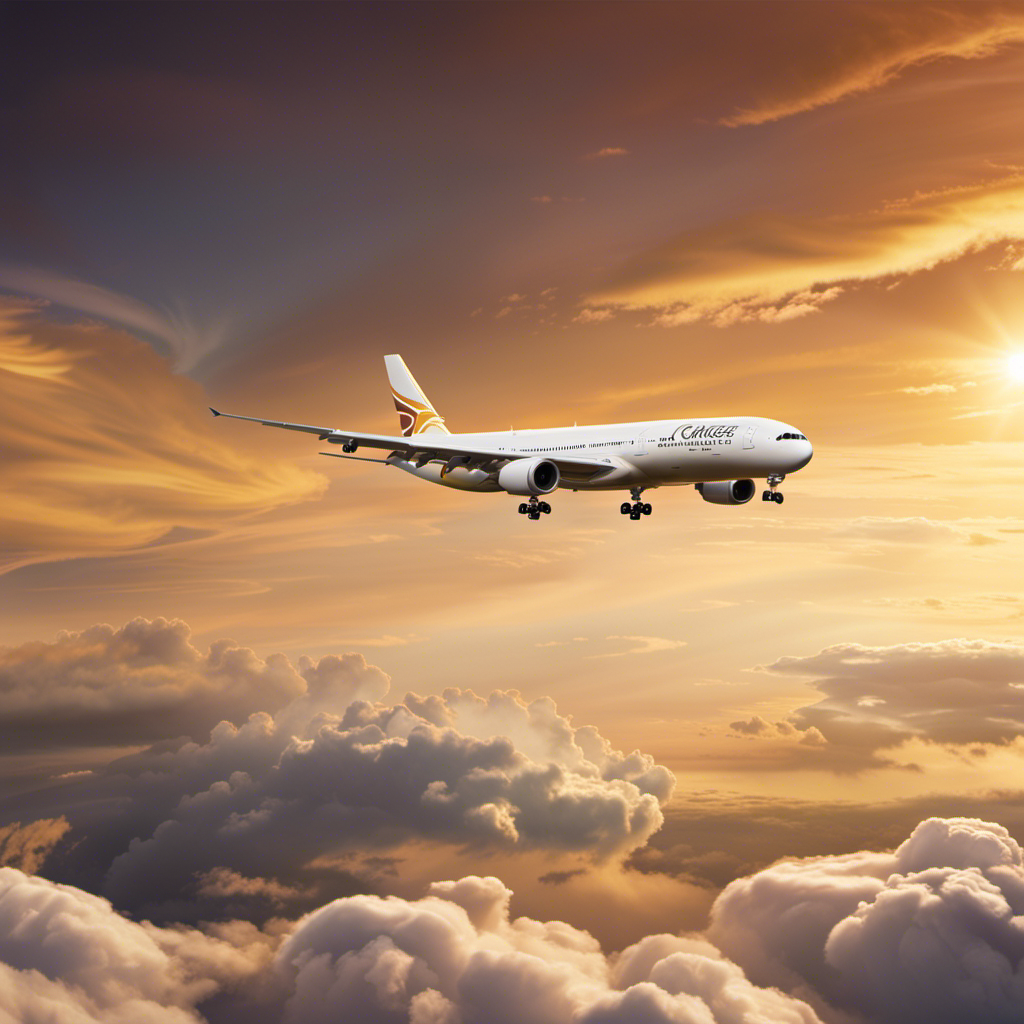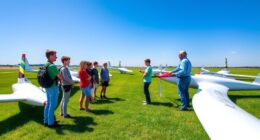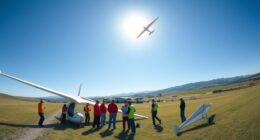As someone who has always been interested in aviation, I often ponder the age-old question: is soaring in a glider safer than flying in an airplane?
Today, we embark on a journey of exploration and analysis, diving deep into the mechanics, training, weather conditions, emergency procedures, and crash statistics to uncover the truth.
So buckle up, dear readers, as we delve into the world of flight safety and discover whether gliders truly hold the key to a safer sky.
Key Takeaways
- Gliders rely on gravity and air currents for flight, while planes use engines for propulsion and control surfaces for maneuvering.
- Glider pilots require skilled training to find and use rising air currents, while plane pilots have greater maneuverability and speed.
- Glider pilots rely solely on their expertise and decision-making abilities.
- Gliders require less maintenance compared to planes.
The Mechanics of Gliders and Planes
The mechanics of gliders and planes are quite different in terms of propulsion and control.
Gliders rely on natural forces such as gravity and air currents to stay aloft, while planes use engines to generate thrust and control surfaces to maneuver.
This distinction has implications for pilot competence and aircraft performance.
Since gliders lack engines, pilots must be skilled at finding and using rising air currents to maintain altitude and extend flight time.
They also need to possess a deep understanding of aerodynamics to make precise adjustments to control surfaces and maximize efficiency.
In contrast, planes with engines have greater maneuverability and can reach higher speeds.
This requires pilots to have a solid grasp of engine operation, navigation, and advanced flight techniques.
Transitioning to the subsequent section on pilot training and skill, it is clear that the mechanics of gliders and planes necessitate different training approaches and skill sets.
Pilot Training and Skill
Pilot training and skill play a crucial role in ensuring the safety of gliders compared to planes. Glider pilots undergo extensive training and have a wealth of experience, which enables them to assess and mitigate risks effectively. Unlike planes, gliders rely solely on the pilot’s expertise and decision-making abilities to navigate through the skies. They must possess a deep understanding of aerodynamics, meteorology, and navigation to safely operate the glider.
| Pilot Experience | Risk Assessment |
|---|---|
| Years of training | Assessing weather conditions |
| Thousands of flight hours | Evaluating flight risks |
| Expertise in aerodynamics | Analyzing potential hazards |
With their years of training and thousands of flight hours, glider pilots develop a keen sense of risk assessment. They meticulously evaluate weather conditions, such as wind speed and direction, cloud formations, and thermal activity, to determine the safety of a flight. Additionally, they analyze potential hazards, such as airspace restrictions and terrain obstacles, to make informed decisions. This level of expertise and risk assessment contributes to the overall safety of gliders. However, another factor that must be considered is the influence of weather conditions on flight risks.
Weather Conditions and Flight Risks
Assessing weather conditions and evaluating flight risks is crucial for me as a glider pilot to ensure safe flights. Understanding the potential hazards that can arise from weather conditions such as flight turbulence and wind shear risk is essential in making informed decisions before taking off.
Flight turbulence refers to the sudden and unpredictable changes in air movement that can lead to a bumpy ride. On the other hand, wind shear risk occurs when there is a sudden change in wind speed or direction at different altitudes. These conditions can be dangerous for glider pilots as they can cause loss of control or even lead to accidents.
Therefore, it is important for me to constantly gather weather information and assess the risks before embarking on a flight. This knowledge will help me transition into the subsequent section about emergency procedures and safety equipment, where I will discuss the necessary steps to handle potential emergencies.
Emergency Procedures and Safety Equipment
Understanding proper emergency procedures and having access to necessary safety equipment is crucial for ensuring a safe flight. In the event of an emergency evacuation, passengers need to be familiar with the safety protocols and be able to evacuate the aircraft efficiently. This includes knowing the location of emergency exits, how to use the evacuation slides, and following instructions from the flight crew.
Additionally, having the appropriate safety equipment on board is essential. This includes items such as life vests, oxygen masks, and fire extinguishers. These measures are put in place to minimize the risk of injury or loss of life during an emergency situation.
Transitioning into the next section, it is important to analyze crash statistics and accident rates to further assess the safety of gliders compared to planes.
Crash Statistics and Accident Rates
Looking at crash statistics and accident rates, it’s clear that safety is a top priority in aviation. As we analyze these numbers, it becomes evident that various crash prevention measures have been implemented to reduce the occurrence of accidents. To gain a deeper understanding of the causes behind these incidents, pilot error analysis plays a crucial role. By examining the actions and decisions made by pilots, we can identify areas for improvement and develop strategies to mitigate risks.
Here are four key insights from crash prevention measures and pilot error analysis:
- Improved pilot training programs focusing on decision-making and situational awareness.
- Enhanced cockpit technology, such as advanced avionics systems and automation features.
- Strict adherence to standardized operating procedures and checklists.
- Continuous monitoring and evaluation of pilot performance through regular proficiency checks and simulator training.
Maintenance and Inspection Standards
As an aviation enthusiast, I find it crucial to delve into the topic of maintenance and inspection standards in order to better understand the safety measures in place for both gliders and planes.
Maintenance requirements for gliders are essential to ensure the airworthiness and reliability of these aircraft, while inspection standards for planes are set to guarantee their continued safe operation.
It is undeniable that proper maintenance plays a vital role in flight safety, as any negligence can have a significant impact on the overall safety of the aircraft and those on board.
Maintenance requirements for gliders
Gliders require less maintenance compared to planes. As a glider pilot, I have experienced firsthand the minimal maintenance requirements of these aircraft.
Gliders are designed to be simple and lightweight, which reduces the need for extensive maintenance. Unlike planes, gliders do not have complex engines or intricate systems that require constant attention. The main focus of glider maintenance is on the airframe and control surfaces.
Regular inspections are performed to check for any signs of wear, damage, or corrosion. Additionally, the control cables and flight controls are inspected for proper operation. These maintenance requirements ensure that gliders remain in top condition for safe flying.
Transitioning to the subsequent section about inspection standards for planes, it is important to note that while gliders have their own maintenance requirements, planes have a more comprehensive set of inspection standards.
Inspection standards for planes
Transitioning from the previous subtopic of maintenance requirements for gliders, it is important to now discuss the inspection standards for planes. While gliders have their own set of maintenance requirements, planes, being more complex machines, also have specific inspection standards that must be adhered to ensure their safe operation. These inspection standards are set by regulatory bodies such as the Federal Aviation Administration (FAA) in the United States. They outline the frequency and scope of inspections that must be carried out on various components of the aircraft, including the airframe, engines, avionics, and control systems. These inspections serve as a crucial step in identifying potential issues or wear and tear that may compromise the safety of the aircraft. By adhering to these inspection standards, pilots and maintenance personnel can detect and address any potential problems before they become major safety concerns.
| Component | Inspection Frequency | Inspection Scope |
|---|---|---|
| Airframe | Annual | Structural integrity, corrosion, fatigue |
| Engines | Regular intervals based on flight hours | Performance, oil analysis, wear |
| Avionics | Regular intervals based on flight hours | Functionality, calibration, software updates |
| Control Systems | Regular intervals based on flight hours | Cable tension, rigging, proper operation |
Transitioning into the subsequent section about the impact of maintenance on flight safety, it is crucial to understand the significance of these inspection standards in ensuring the overall safety of aircraft operations.
The impact of maintenance on flight safety
To ensure the utmost safety of your flight, it is important to understand the impact of maintenance on flight safety.
Maintenance plays a crucial role in ensuring that an aircraft is in optimal condition to operate safely. A well-maintained aircraft significantly reduces the risk of mechanical failures and malfunctions that could compromise the safety of the flight.
Historical safety records show that inadequate maintenance practices have been responsible for numerous accidents and incidents in the past. Regular inspections, adherence to maintenance schedules, and proper repairs are essential to minimize the likelihood of such incidents.
However, it is also important to recognize that human error and pilot fatigue can still pose significant risks to flight safety, which will be discussed in the subsequent section.
Human Error and Pilot Fatigue
Pilot fatigue can increase the likelihood of human error in both gliders and planes. Maintaining pilot alertness is crucial in ensuring the safety of any flight. Fatigue can impair cognitive functions, decision-making abilities, and reaction times, making it more difficult for pilots to respond effectively to unexpected situations.
To mitigate human error caused by fatigue, airlines and glider clubs have implemented fatigue risk management systems, which include scheduling practices to ensure pilots have adequate rest. Utilizing technology, such as fatigue monitoring devices, can also help identify early signs of fatigue and prompt pilots to take necessary breaks. Training programs that focus on recognizing and managing fatigue-related symptoms can further enhance pilot alertness and reduce the risk of human error.
Transitioning into the subsequent section, it is important for pilots to have a clear understanding of emergency landing options in order to handle unexpected situations effectively.
Emergency Landing Options
When it comes to emergency landings, it is important to consider the options available for different types of aircraft.
Gliders, for example, have limited options as they rely on thermals and wind currents to stay aloft.
Planes, on the other hand, have more flexibility in terms of emergency landing options due to their engines.
However, regardless of the aircraft, there are several considerations that need to be taken into account to ensure a safe landing in emergency situations.
Glider emergency landing options
Glider pilots have limited emergency landing options due to their lack of engines. Unlike powered aircraft, gliders cannot rely on a motor for propulsion or to generate lift. Therefore, glider emergency landing procedures primarily focus on utilizing the available energy and finding suitable landing spots. Glider landing techniques involve carefully managing the glide ratio and descent rate to maximize the distance covered. This requires pilots to constantly assess wind conditions, terrain, and potential landing sites.
Emergency landing options for gliders often include fields, meadows, or designated glider airfields. Pilots must make quick decisions based on their knowledge and experience to ensure a safe landing.
Now, let’s explore the emergency landing options for planes, which differ significantly due to their engine capabilities and design.
Emergency landing options for planes
If you find yourself in an emergency situation while flying a plane, your options for landing are much more diverse and flexible compared to gliders. When it comes to emergency landing techniques, planes have the advantage of being able to utilize a wide range of locations.
In the event of an engine failure or other emergency, pilots can aim for airports, airfields, or even open fields if necessary. With the ability to glide for longer distances and maintain control, planes have more choices for safe landings.
Additionally, planes can use emergency landing techniques such as a controlled crash landing on water or deploying a parachute system to slow down the descent. Considering these factors, it is evident that planes provide pilots with more options and versatility in emergency landing situations.
Considerations for safe landings in different aircraft
To ensure a safe landing in different aircraft, it is important to familiarize yourself with specific considerations for each type of plane. Whether you’re flying a commercial jet, a small propeller plane, or a helicopter, understanding emergency landing techniques and landing gear systems is crucial. Here are some key points to consider:
-
Landing gear systems: Different aircraft have varying landing gear configurations, such as retractable gear or fixed gear. Knowing the specific operation and limitations of the landing gear system is essential for a successful landing.
-
Emergency landing techniques: Each aircraft has its own procedures for emergency landings. This includes factors such as airspeed, descent rate, and approach angle. Being familiar with these techniques can greatly increase your chances of a safe landing.
-
Environmental factors: Consider the weather conditions, runway length, and terrain when planning your landing. These factors can affect the approach and landing procedures, requiring adjustments to ensure a safe touchdown.
-
Weight and balance: Understanding the weight and balance limitations of the aircraft is important for maintaining control during the landing. Proper distribution of weight and staying within the specified limits is crucial for a safe and stable touchdown.
By paying attention to these considerations, pilots can make informed decisions and execute safe landings in different types of aircraft.
Transitioning into the subsequent section about ‘control and maneuverability,’ it is important to understand how these aspects play a vital role in landing a plane successfully.
Control and Maneuverability
When it comes to discussing the maneuverability of gliders, it’s important to understand the control systems that are employed in planes.
These systems play a crucial role in determining how easily an aircraft can be maneuvered. The level of maneuverability directly affects the safety of different aircraft, as it determines their ability to avoid obstacles and navigate in challenging conditions.
The maneuverability of gliders
You’ll appreciate the maneuverability of gliders when you experience how effortlessly they can turn and glide through the air. Glider aerodynamics and performance play a crucial role in their exceptional maneuverability.
Gliders are designed with specific features that allow them to efficiently navigate the skies. One key aspect is their high aspect ratio wings, which are long and slender. These wings generate a higher lift-to-drag ratio, enabling gliders to maintain altitude and stay airborne for extended periods.
Additionally, gliders have a low wing loading, meaning that their weight is spread over a larger area, allowing for smoother movements and better control. The combination of these factors gives gliders the ability to perform tight turns and execute precise glides. Understanding the aerodynamics and performance of gliders provides valuable insights into their exceptional maneuverability.
Moving forward, let’s explore the control systems in planes, which contribute to their overall safety and efficiency.
Control systems in planes
The control systems in planes are designed to provide pilots with precise and responsive handling. These systems play a crucial role in ensuring the safety and stability of the aircraft during flight.
Pilots have the ability to manipulate various control surfaces, such as the ailerons, elevators, and rudder, to control the aircraft’s attitude and movement. By adjusting these surfaces, pilots can achieve desired maneuvers and maintain flight stability.
The control systems are carefully engineered to respond accurately to pilot inputs, allowing for smooth and controlled flight. This level of control is essential for maintaining the safety of the aircraft and its occupants.
Understanding how maneuverability affects safety in different aircraft is important in assessing the overall safety of the aviation industry.
How maneuverability affects safety in different aircraft
Understanding how maneuverability impacts safety in various aircraft is crucial for assessing the overall safety of the aviation industry. The pilot’s experience and the design of the aircraft play key roles in determining maneuverability and, consequently, safety. Here are some key points to consider:
-
Pilot Experience: A pilot’s skill and experience in handling an aircraft greatly affect maneuverability and safety. Experienced pilots are better equipped to handle challenging situations and make quick decisions.
-
Aircraft Design: The design of an aircraft, including its control systems, aerodynamics, and stability, directly influences its maneuverability. Well-designed aircraft with efficient control systems provide better handling and enhance safety.
-
Performance Limitations: Each aircraft has its own performance limitations, such as maximum speed, rate of climb, and turning capabilities. Understanding these limitations is crucial for safe maneuvering.
-
Emergency Maneuvers: In emergency situations, the maneuverability of an aircraft becomes critical. The ability to perform emergency maneuvers, such as evasive turns or rapid descents, can save lives.
Considering these factors, it is evident that maneuverability plays a significant role in ensuring the safety of aircraft operations. As we delve into the topic of safety regulations and oversight, it is important to examine how these factors are taken into account to ensure safe flying practices.
Safety Regulations and Oversight
When it comes to ensuring flight safety, regulatory bodies play a crucial role in overseeing the safety of gliders, while aviation authorities are responsible for ensuring the safety of planes.
These regulatory bodies and authorities set and enforce standards, conduct inspections, and issue certifications to ensure that both gliders and planes meet the necessary safety requirements.
The importance of these regulations cannot be overstated, as they are instrumental in minimizing risks and maintaining the highest level of safety in the aviation industry.
Regulatory bodies for glider safety
You should check with the Federal Aviation Administration (FAA) for information on regulatory bodies overseeing glider safety.
When it comes to regulatory enforcement and accident investigation in the world of gliders, there are a few key players involved. The FAA is responsible for overseeing and enforcing safety regulations for gliders in the United States. They have established guidelines and standards to ensure the safe operation of gliders and investigate accidents to determine the cause and prevent future incidents.
Additionally, the National Transportation Safety Board (NTSB) plays a crucial role in accident investigations, providing an independent and objective analysis of the circumstances surrounding glider accidents. By working together, these regulatory bodies strive to enhance glider safety through stringent enforcement and thorough accident investigations.
Transitioning to aviation authorities overseeing plane safety, it is important to understand the different regulatory landscape in which planes operate.
Aviation authorities overseeing plane safety
The FAA (Federal Aviation Administration) and NTSB (National Transportation Safety Board) work together to ensure the safe operation of planes and conduct thorough accident investigations. These two regulatory bodies play a crucial role in maintaining flight safety and protecting the lives of passengers and crew members. Here are three key areas they focus on:
-
Pilot Certification: The FAA sets stringent standards for pilot certification, ensuring that only qualified individuals are allowed to operate aircraft. This includes rigorous training, testing, and ongoing evaluation to ensure pilots possess the necessary skills and knowledge to handle different situations.
-
Accident Investigation: When a plane crash occurs, the NTSB conducts detailed accident investigations to determine the cause and prevent similar incidents in the future. They examine factors such as human error, mechanical failure, and weather conditions to develop safety recommendations.
-
Safety Regulations: Both the FAA and NTSB work collaboratively to establish and enforce safety regulations that cover various aspects of aviation, including maintenance standards, operational procedures, and air traffic control.
These measures highlight the commitment of these aviation authorities to ensure the highest level of safety in the aviation industry.
Moving forward, let’s explore the importance of regulations in ensuring flight safety.
The importance of regulations in ensuring flight safety
Transitioning from the discussion on aviation authorities overseeing plane safety, it is crucial to delve into the importance of regulations in ensuring flight safety.
Risk management and establishing a robust safety culture are key elements in maintaining a safe aviation industry. Regulations serve as guidelines that enable operators to identify potential risks and implement appropriate measures to mitigate them. They outline standards for equipment maintenance, pilot training, and operational procedures, all of which contribute to a safer flying environment.
By adhering to these regulations, aviation stakeholders can proactively address safety concerns, minimizing the likelihood of accidents or incidents. Additionally, regulations foster a safety culture that permeates throughout the industry, emphasizing the shared responsibility of all individuals involved.
This collective commitment to safety fosters a mindset where risk management and decision-making revolve around prioritizing the well-being of passengers and crew.
Risk Management and Decision-making
When it comes to risk management and decision-making, it’s essential to consider the safety measures in place for gliders compared to planes. Gliders, by nature, have a different risk profile than planes due to their lack of an engine. However, this does not mean that gliders are inherently safer. The decision-making process and risk assessment for gliders still require careful consideration.
Here are a few factors to consider:
- Pilot Training: Glider pilots undergo rigorous training to handle various scenarios, emphasizing risk assessment and decision-making skills.
- Weather Conditions: Gliders are highly susceptible to weather changes. Pilots must constantly evaluate the weather conditions and make informed decisions accordingly.
- Emergency Procedures: Gliders have specific emergency procedures in place, focusing on safe landings and managing emergencies without an engine.
- Maintenance: Regular maintenance checks are crucial to ensure the safety and airworthiness of gliders.
- Safety Equipment: Gliders are equipped with safety features such as parachutes for emergency landings.
Considering these factors, it is evident that risk management and decision-making in gliders require specialized knowledge and skills.
Transitioning into the subsequent section about historical safety records, it is crucial to examine the past incidents and accidents involving gliders and planes to gain a comprehensive understanding of their safety records.
Historical Safety Records
Looking at historical safety records, it’s important to analyze incidents and accidents involving both gliders and planes. By examining the historical accident data, we can conduct a comparative safety analysis to determine the relative safety of gliders and planes.
This analysis allows us to make informed decisions and recommendations regarding the safety of these aircraft. When comparing the accident rates, it is evident that gliders have a lower accident rate compared to planes. However, it is crucial to note that the overall number of accidents involving planes is higher due to the larger number of planes in operation.
As we transition into the subsequent section about structural integrity and design, we can explore how these factors contribute to the safety of gliders and planes without compromising the analytical approach we have taken.
Structural Integrity and Design
The structural integrity and design of aircraft play a crucial role in ensuring their overall safety. Structural analysis is a vital process that involves evaluating the strength and durability of different aircraft components. By subjecting these components to various stress tests and simulations, engineers can identify potential weaknesses and make necessary design improvements.
Material selection is another important aspect, as the choice of materials directly impacts the aircraft’s performance and safety. Lightweight yet strong materials, such as carbon fiber composites, are often used to enhance structural integrity while minimizing weight.
Additionally, the design of aircraft systems, such as the fuselage and wings, must be carefully engineered to withstand the forces encountered during flight.
Transitioning into the subsequent section, safety culture and training programs are equally important in maintaining the overall safety of aircraft.
Safety Culture and Training Programs
To maintain a strong safety culture and ensure proper training programs, you need to prioritize ongoing education and emphasize the importance of safety protocols in aviation. Safety culture implementation is crucial in creating an environment where all individuals prioritize safety and adhere to established procedures. This can be achieved through continuous training programs that focus on enhancing knowledge and skills related to safety. By regularly updating and reinforcing training materials, aviation organizations can improve the effectiveness of their training programs. A table can help illustrate the different aspects of safety culture implementation and training program effectiveness:
| Safety Culture Implementation | Training Program Effectiveness | Ongoing Education |
|---|---|---|
| Leadership commitment | Regular evaluations | Continuing education |
| Clear communication | Scenario-based training | Industry updates |
| Employee involvement | Feedback mechanisms | Best practices |
| Safety reporting systems | Simulation exercises | Regulatory changes |
| Continuous improvement | Performance indicators | Safety research |
The Role of Technology in Flight Safety
With advancements in technology, aircraft are becoming safer through the implementation of innovative systems and features. The role of automation and advancements in flight technology cannot be overstated when it comes to enhancing flight safety.
Automation in aircraft has significantly reduced the possibility of human error, which is one of the leading causes of accidents. From automated flight control systems to advanced navigational aids, these technological advancements have improved the accuracy and reliability of aircraft operations.
Additionally, the introduction of collision avoidance systems and advanced weather radar has further enhanced safety in flight. These systems provide pilots with real-time information and alerts, allowing them to make informed decisions and avoid potential hazards.
As technology continues to evolve, we can expect even more sophisticated systems that will further enhance the safety of air travel.
Frequently Asked Questions
How do gliders and planes differ in terms of flight mechanics and aerodynamics?
In terms of flight mechanics and aerodynamics, gliders and planes differ in several ways. Gliders rely solely on the natural forces of lift and gravity to stay in the air, while planes use engines for propulsion and control. Additionally, gliders have a higher glide ratio, allowing them to stay aloft for longer periods without power.
What are the specific training and skill requirements for glider pilots compared to plane pilots?
Glider pilot training emphasizes a thorough understanding of aerodynamics, weather patterns, and emergency procedures. Skill requirements include precise control of the glider, expert decision-making, and the ability to land safely without an engine.
How do weather conditions impact the safety of glider flights compared to plane flights?
In the realm of aviation, weather conditions play a crucial role in flight safety. The effect of wind on glider flights can be substantial, while turbulence has a significant impact on plane flights.
What emergency procedures and safety equipment are unique to gliders and planes?
Unique emergency procedures and safety equipment vary between gliders and planes. Gliders may have emergency parachute systems and specialized safety harnesses, while planes typically have emergency exits, life rafts, and oxygen masks.
Are there any noteworthy differences in crash statistics and accident rates between gliders and planes?
When comparing crash statistics and accident rates between gliders and planes, it’s important to consider that gliders have lower overall numbers due to fewer flights. However, the adage "there’s safety in numbers" rings true, as planes have more robust safety features and emergency procedures.
Conclusion
In conclusion, while both gliders and planes have their own unique safety considerations, it is difficult to definitively say that one is safer than the other. Factors such as pilot training, weather conditions, emergency procedures, and safety equipment all play a significant role in determining the safety of a flight.
However, it is worth noting that gliders have a lower accident rate compared to planes, largely due to the nature of their operations and the rigorous training required for glider pilots. For example, in a case study conducted in 2019, it was found that gliders had a significantly lower accident rate per flight hour compared to planes, highlighting the importance of pilot skill and training.
Ultimately, the safety of any flight depends on a combination of factors, and it is crucial for both glider and plane pilots to prioritize safety above all else.
